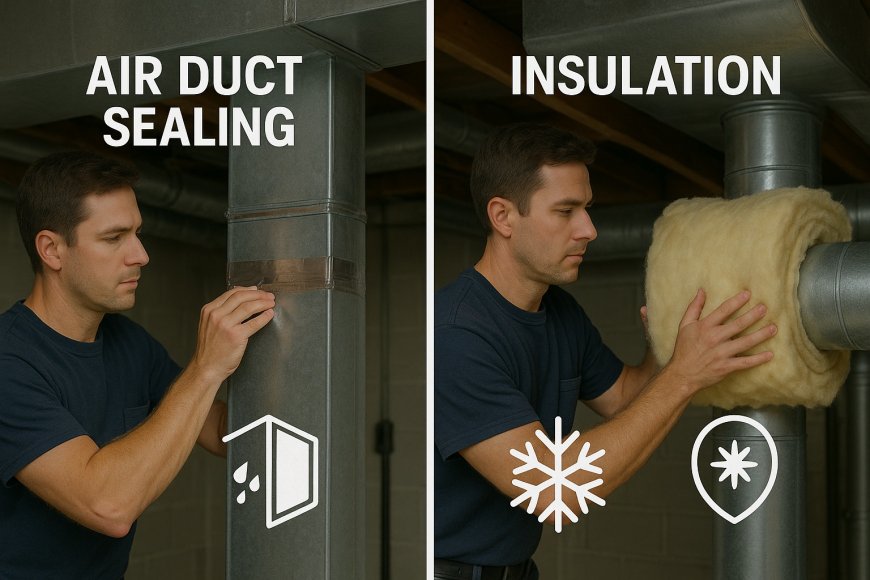How Is Air Duct Sealing Different from Insulation?
Learn the key differences between air duct sealing and insulation, and how each improves energy efficiency and indoor comfort in your home.

Air Duct Sealing is often mentioned alongside insulation, but these two home improvement steps target different problems and work in their own unique ways. If youve ever wondered why your home still feels drafty even after beefing up your attic insulation, its probably because your ductwork needs some attention too. Understanding how Air Duct Sealing differs from insulation can help you create a cozy, energy-smart home that wont send your energy bills through the roof.
Air Duct Sealing: Plugging the Leaks
Imagine your homes ductwork as a network of hidden highways moving warm or cool air to every room. Over time, these highways can develop cracks, gaps, or loose joints. Air Duct Sealing is all about tracking down these tiny escapes and shutting them for good. The goal here isn't to keep air hot or cold, but simply to ensure that all the air your system works hard to condition actually arrives where its supposed to. If you skip this step, you might as well be trying to fill a bucket with holes in the bottomno matter how much you pour in, youre losing a lot along the way.
Insulation: Wrapping it Up Warm
If Air Duct Sealing is about plugging holes, insulation is more like giving your ducts a cozy blanket. Insulation wraps around the outside of your ducts (and also your attic, walls, and floors), slowing down the transfer of heat in or out. Think of it as the difference between wearing a windbreaker (which blocks drafts) and a thick sweater (which keeps you warm). Insulation doesnt stop air from escapingthats the job of sealingbut it helps the air inside your ducts stay at the right temperature as it travels to your rooms. Without insulation, even perfectly sealed ducts will lose some warmth or coolness to the chilly or hot spaces they run through.
Side-by-Side: How Sealing & Insulation Compare
| Feature | Air Duct Sealing | Insulation |
|---|---|---|
| Purpose | Stops air escaping from ducts | Slows down heat transfer |
| Where Applied | At duct joints, seams, holes | Around the outside of ducts, attics, walls |
| Main Benefit | Delivers all conditioned air to rooms | Keeps air inside ducts at the desired temperature |
| Common Materials | Mastic, foil tape, sealants | Fiberglass wrap, foam, cellulose |
| Energy Savings | Prevents wasted energy from leaks | Reduces heating/cooling losses |
Why You Need Both for a Comfortable Home
Its pretty common for folks to focus on just one of these fixes, thinking itll do the trick. But imagine you only sealed the ducts without adding insulationyour air would reach its destination, but might arrive hotter or colder than you want. On the flip side, if you only add insulation and skip sealing, the air you worked so hard to condition could leak out before it even gets to the rooms youre using. For the best comfort (and to keep your wallet happy), its smart to tackle both. Sealing keeps your air moving in the right direction, and insulation keeps that air at the right temperature until it gets where its going.
A well-sealed duct system is like a straight shot of espresso for your HVACdirect, powerful, and no energy wasted on the way.
Wrapping It All Up
So, heres the bottom line: Air Duct Sealing and insulation arent the same, but theyre both crucial pieces of the home comfort puzzle. Sealing is about making sure your conditioned air stays in the system and gets delivered right where its needed, while insulation is all about keeping that air at a comfortable temperature as it moves through your home. When you combine both, youll notice rooms that actually feel like the thermostat says they shouldand you might even see a nice dip in your energy bills, too. If youre aiming for a home thats cozy in winter, cool in summer, and easy on your budget, dont overlook the magic that happens when Air Duct Sealing and insulation team up.
Read More: Louisville Air Duct Cleaning





































